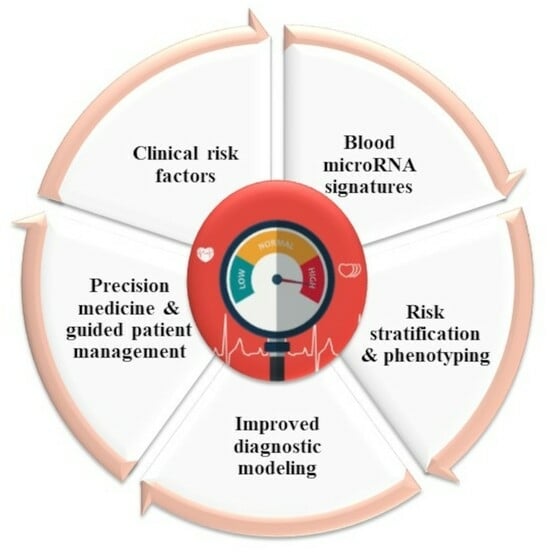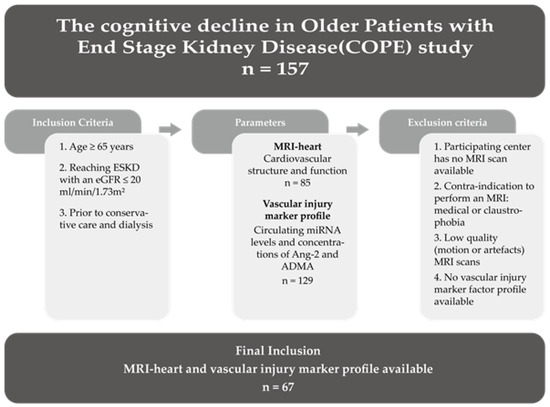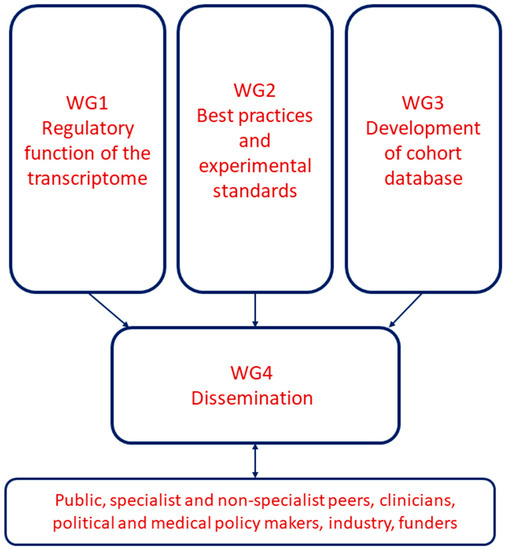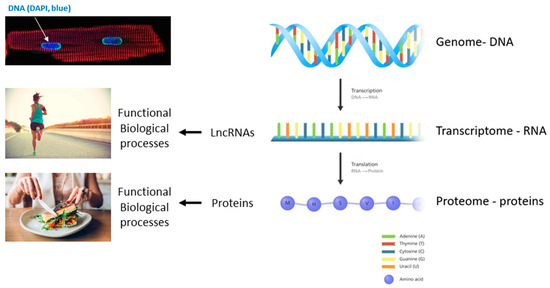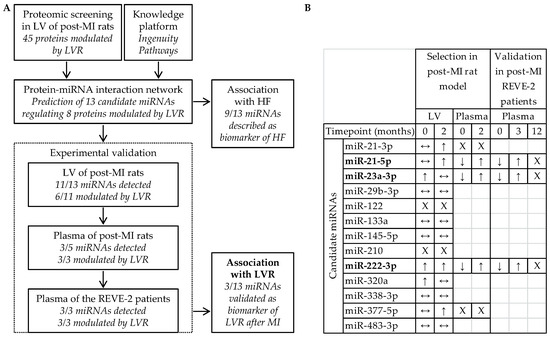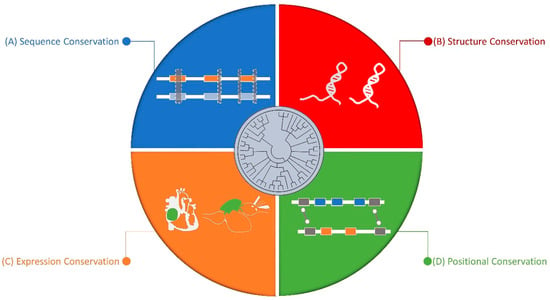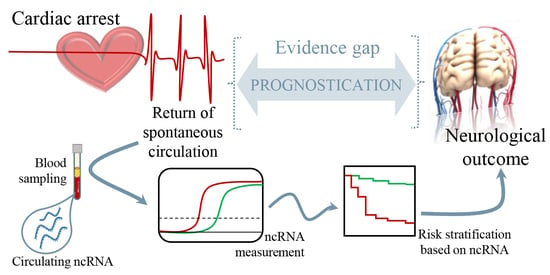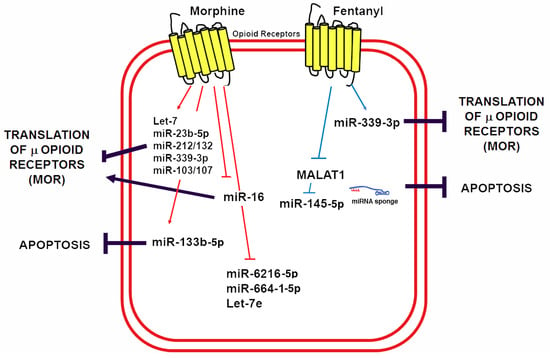Regulatory RNAs in Cardiovascular Development and Disease
A topical collection in Non-Coding RNA (ISSN 2311-553X).
Viewed by 46933
Share This Topical Collection
Editors
 Prof. Dr. Francisco J. Enguita
Prof. Dr. Francisco J. Enguita
 Prof. Dr. Francisco J. Enguita
Prof. Dr. Francisco J. Enguita
E-Mail
Website
Co-Collection Editor
Faculdade de Medicina, Instituto de Medicina Molecular, Universidade de Lisboa, Lisboa, Portugal
Interests: non-coding RNAs; cardiovascular diseases; infectious diseases; cell-to-cell communication; circulating RNAs; biomarkers
Special Issues, Collections and Topics in MDPI journals
 Dr. Andrea Caporali
Dr. Andrea Caporali
 Dr. Andrea Caporali
Dr. Andrea Caporali
E-Mail
Website
Co-Collection Editor
University/British Heart foundation Centre for Cardiovascular Science, The University of Edinburgh, Edinburgh, UK
Interests: microRNA; endothelial cells; angiogenesis; vascular biology; ischemic injury; extracellular vesicles
Special Issues, Collections and Topics in MDPI journals
Topical Collection Information
Dear Colleagues,
Regulatory RNAs, including microRNAs (miRNAs), long non-coding RNAs (lncRNAs) and circular RNAs (circRNAs), have attracted a great deal of attention from the cardiovascular community. They can be expressed in an organ-specific manner and participate in the regulation of important biological processes.
Several regulatory RNAs are dysregulated in many cardiovascular diseases, such as heart failure, hypertension, coronary artery disease, and myocardial infarction, suggesting that they might play an important role in regulating the expression of genes involved in such diseases.
In the last few years, different studies have demonstrated the importance of regulatory RNAs in cardiac development and cell differentiation.
The observation that regulatory RNAs can be found circulating in the blood supports their potential as disease markers. Recent studies present encouraging results for disease prognosis and therapy.
This Topical Collection is focused on the understanding of the role of regulatory RNAs (miRNAs, lncRNAs, circRNAs) in cardiovascular development and disease and their potential as biomarkers and therapeutic targets. We will consider original manuscripts, as well as reviews. Topics of interest include:
- Regulatory RNAs in cardiovascular development
- Regulatory RNAs in cardiovascular disease
- Cardiovascular disease therapeutics involving regulatory RNAs
- Regulatory RNAs as cardiovascular disease biomarkers
Dr. Yvan Devaux
Collection EditorProf. Dr. Francisco J. Enguita
Dr. Andrea Caporali
Co-Collection Editors
Manuscript Submission Information
Manuscripts should be submitted online at www.mdpi.com by registering and logging in to this website. Once you are registered, click here to go to the submission form. Manuscripts can be submitted until the deadline. All submissions that pass pre-check are peer-reviewed. Accepted papers will be published continuously in the journal (as soon as accepted) and will be listed together on the collection website. Research articles, review articles as well as short communications are invited. For planned papers, a title and short abstract (about 100 words) can be sent to the Editorial Office for announcement on this website.
Submitted manuscripts should not have been published previously, nor be under consideration for publication elsewhere (except conference proceedings papers). All manuscripts are thoroughly refereed through a single-blind peer-review process. A guide for authors and other relevant information for submission of manuscripts is available on the Instructions for Authors page. Non-Coding RNA is an international peer-reviewed open access semimonthly journal published by MDPI.
Please visit the Instructions for Authors page before submitting a manuscript.
The Article Processing Charge (APC) for publication in this open access journal is 1800 CHF (Swiss Francs).
Submitted papers should be well formatted and use good English. Authors may use MDPI's
English editing service prior to publication or during author revisions.
Keywords
- heart
- vascular system
- cardiovascular disease
- non-coding RNAs
- regulatory RNAs
- miRNAs
- lncRNAs
- circRNAs
- biomarkers
- functional genomics
- transcriptomics
- regulation of gene expression
- collaboration
- networking
- precision medicine
Published Papers (10 papers)
Open AccessArticle
A Machine Learning Model Based on microRNAs for the Diagnosis of Essential Hypertension
by
Amela Jusic, Inela Junuzovic, Ahmed Hujdurovic, Lu Zhang, Mélanie Vausort and Yvan Devaux
Viewed by 1790
Abstract
Introduction: Hypertension is a major and modifiable risk factor for cardiovascular diseases. Essential, primary, or idiopathic hypertension accounts for 90–95% of all cases. Identifying novel biomarkers specific to essential hypertension may help in understanding pathophysiological pathways and developing personalized treatments. We tested whether
[...] Read more.
Introduction: Hypertension is a major and modifiable risk factor for cardiovascular diseases. Essential, primary, or idiopathic hypertension accounts for 90–95% of all cases. Identifying novel biomarkers specific to essential hypertension may help in understanding pathophysiological pathways and developing personalized treatments. We tested whether the integration of circulating microRNAs (miRNAs) and clinical risk factors via machine learning modeling may provide useful information and novel tools for essential hypertension diagnosis and management. Materials and methods: In total, 174 participants were enrolled in the present observational case–control study, among which, there were 89 patients with essential hypertension and 85 controls. A discovery phase was conducted using small RNA sequencing in whole blood samples obtained from age- and sex-matched hypertension patients (n = 30) and controls (n = 30). A validation phase using RT-qPCR involved the remaining 114 participants. For machine learning, 170 participants with complete data were used to generate and evaluate the classification model. Results: Small RNA sequencing identified seven miRNAs downregulated in hypertensive patients as compared with controls in the discovery group, of which six were confirmed with RT-qPCR. In the validation group, miR-210-3p/361-3p/362-5p/378a-5p/501-5p were also downregulated in hypertensive patients. A machine learning support vector machine (SVM) model including clinical risk factors (sex, BMI, alcohol use, current smoker, and hypertension family history), miR-361-3p, and miR-501-5p was able to classify hypertension patients in a test dataset with an AUC of 0.90, a balanced accuracy of 0.87, a sensitivity of 0.83, and a specificity of 0.91. While five miRNAs exhibited substantial downregulation in hypertension patients, only miR-361-3p and miR-501-5p, alongside clinical risk factors, were consistently chosen in at least eight out of ten sub-training sets within the SVM model. Conclusions: This study highlights the potential significance of miRNA-based biomarkers in deepening our understanding of hypertension’s pathophysiology and in personalizing treatment strategies. The strong performance of the SVM model highlights its potential as a valuable asset for diagnosing and managing essential hypertension. The model remains to be extensively validated in independent patient cohorts before evaluating its added value in a clinical setting.
Full article
►▼
Show Figures
Open AccessFeature PaperArticle
Circulating miRNAs and Vascular Injury Markers Associate with Cardiovascular Function in Older Patients Reaching End-Stage Kidney Disease
by
Qiao Zhao, Sabine J. L. Nooren, Laurien E. Zijlstra, Jos J. M. Westenberg, Lucia J. M. Kroft, J. Wouter Jukema, Noeleen C. Berkhout-Byrne, Ton J. Rabelink, Anton Jan van Zonneveld, Marjolijn van Buren, Simon P. Mooijaart and Roel Bijkerk
Viewed by 2848
Abstract
The prevalence of end-stage kidney disease (ESKD) is rapidly increasing and mostly occurring in patients aged 65 years or older. The main cause of death in these patients is cardiovascular disease (CVD). Novel markers of vascular integrity may thus be of clinical value
[...] Read more.
The prevalence of end-stage kidney disease (ESKD) is rapidly increasing and mostly occurring in patients aged 65 years or older. The main cause of death in these patients is cardiovascular disease (CVD). Novel markers of vascular integrity may thus be of clinical value for identifying patients at high risk for CVD. Here we associated the levels of selected circulating angiogenic miRNAs, angiopoietin-2 (Ang-2) and asymmetric dimethylarginine (ADMA) with cardiovascular structure and function (as determined by cardiovascular MRI) in 67 older patients reaching ESKD that were included from ‘The Cognitive decline in Older Patients with End stage renal disease’ (COPE) prospective, multicentered cohort study. We first determined the association between the vascular injury markers and specific heart conditions and observed that ESKD patients with coronary heart disease have significantly higher levels of circulating ADMA and miR-27a. Moreover, circulating levels of miR-27a were higher in patients with atrial fibrillation. In addition, the circulating levels of the vascular injury markers were associated with measures of cardiovascular structure and function obtained from cardiovascular MRI: pulse wave velocity (PWV), ejection fraction (EF) and cardiac index (CI). We found Ang-2 and miR-27a to be strongly correlated to the PWV, while Ang-2 also associated with ejection fraction. Finally, we observed that in contrast to miR-27a, Ang-2 was not associated with a vascular cause of the primary kidney disease, suggesting Ang-2 may be an ESKD-specific marker of vascular injury. Taken together, among older patients with ESKD, aberrant levels of vascular injury markers (miR-27a, Ang-2 and ADMA) associated with impaired cardiovascular function. These markers may serve to identify individuals at higher risk of CVD, as well as give insight into the underlying (vascular) pathophysiology.
Full article
►▼
Show Figures
Open AccessFeature PaperReview
Long Non-Coding RNAs in Cardiovascular Diseases: Potential Function as Biomarkers and Therapeutic Targets of Exercise Training
by
Camila Caldas Martins Correia, Luis Felipe Rodrigues, Bruno Rocha de Avila Pelozin, Edilamar Menezes Oliveira and Tiago Fernandes
Cited by 29 | Viewed by 5989
Abstract
Despite advances in treatments and therapies, cardiovascular diseases (CVDs) remain one of the leading causes of death worldwide. The discovery that most of the human genome, although transcribed, does not encode proteins was crucial for focusing on the potential of long non-coding RNAs
[...] Read more.
Despite advances in treatments and therapies, cardiovascular diseases (CVDs) remain one of the leading causes of death worldwide. The discovery that most of the human genome, although transcribed, does not encode proteins was crucial for focusing on the potential of long non-coding RNAs (lncRNAs) as essential regulators of cell function at the epigenetic, transcriptional, and post-transcriptional levels. This class of non-coding RNAs is related to the pathophysiology of the cardiovascular system. The different expression profiles of lncRNAs, in different contexts of CVDs, change a great potential in their use as a biomarker and targets of therapeutic intervention. Furthermore, regular physical exercise plays a protective role against CVDs; on the other hand, little is known about its underlying molecular mechanisms. In this review, we look at the accumulated knowledge on lncRNAs and their functions in the cardiovascular system, focusing on the cardiovascular pathology of arterial hypertension, coronary heart disease, acute myocardial infarction, and heart failure. We discuss the potential of these molecules as biomarkers for clinical use, their limitations, and how the manipulation of the expression profile of these transcripts through physical exercise can begin to be suggested as a strategy for the treatment of CVDs.
Full article
►▼
Show Figures
Open AccessMeeting Report
A Year in the Life of the EU-CardioRNA COST Action: CA17129 Catalysing Transcriptomics Research in Cardiovascular Disease
by
Emma Louise Robinson, Clarissa Pedrosa da Costa Gomes, Ines Potočnjak, Jan Hellemans, Fay Betsou, David de Gonzalo-Calvo, Monika Stoll, Mehmet Birhan Yilmaz, Bence Ágg, Dimitris Beis, Maria Carmo-Fonseca, Francisco J. Enguita, Soner Dogan, Bilge G. Tuna, Blanche Schroen, Wim Ammerlaan, Gabriela M. Kuster, Irina Carpusca, Thierry Pedrazzini, Costanza Emanueli, Fabio Martelli and Yvan Devauxadd
Show full author list
remove
Hide full author list
| Viewed by 5781
Abstract
The EU-CardioRNA Cooperation in Science and Technology (COST) Action is a European-wide consortium established in 2018 with 31 European country members and four associate member countries to build bridges between translational researchers from academia and industry who conduct research on non-coding RNAs, cardiovascular
[...] Read more.
The EU-CardioRNA Cooperation in Science and Technology (COST) Action is a European-wide consortium established in 2018 with 31 European country members and four associate member countries to build bridges between translational researchers from academia and industry who conduct research on non-coding RNAs, cardiovascular diseases and similar research areas. EU-CardioRNA comprises four core working groups (WG1–4). In the first year since its launch, EU-CardioRNA met biannually to exchange and discuss recent findings in related fields of scientific research, with scientific sessions broadly divided up according to WG. These meetings are also an opportunity to establish interdisciplinary discussion groups, brainstorm ideas and make plans to apply for joint research grants and conduct other scientific activities, including knowledge transfer. Following its launch in Brussels in 2018, three WG meetings have taken place. The first of these in Lisbon, Portugal, the second in Istanbul, Turkey, and the most recent in Maastricht, The Netherlands. Each meeting includes a scientific session from each WG. This meeting report briefly describes the highlights and key take-home messages from each WG session in this first successful year of the EU-CardioRNA COST Action.
Full article
►▼
Show Figures
Open AccessCommentary
The Missing “lnc” between Genetics and Cardiac Disease
by
Maral Azodi, Rick Kamps, Stephane Heymans and Emma Louise Robinson
Cited by 6 | Viewed by 5361
Abstract
Cardiovascular disease (CVD) is one of the biggest threats to public health worldwide. Identifying key genetic contributors to CVD enables clinicians to assess the most effective treatment course and prognosis, as well as potentially inform family members. This often involves either whole exome
[...] Read more.
Cardiovascular disease (CVD) is one of the biggest threats to public health worldwide. Identifying key genetic contributors to CVD enables clinicians to assess the most effective treatment course and prognosis, as well as potentially inform family members. This often involves either whole exome sequencing (WES) or targeted panel analysis of known pathogenic genes. In the future, tailored or personalized therapeutic strategies may be implemented, such as gene therapy. With the recent revolution in deep sequencing technologies, we know that up to 90% of the human genome is transcribed, despite only 2% of the 6 billion DNA bases coding for proteins. The long non-coding RNA (lncRNA) “genes” make up an important and significant fraction of this “dark matter” of the genome. We highlight how, despite lncRNA genes exceeding that of classical protein-coding genes by number, the “non-coding” human genome is neglected when looking for genetic components of disease. WES platforms and pathogenic gene panels still do not cover even characterized lncRNA genes that are functionally involved in the pathophysiology of CVD. We suggest that the importance of lncRNAs in disease causation and progression be taken as seriously as that of pathogenic protein variants and mutations, and that this is maybe a new area of attention for clinical geneticists.
Full article
►▼
Show Figures
Open AccessReview
Long Non-Coding RNA in Vascular Disease and Aging
by
Diewertje I. Bink, Noelia Lozano-Vidal and Reinier A. Boon
Cited by 27 | Viewed by 4212
Abstract
Cardiovascular diseases are the most prominent cause of death in Western society, especially in the elderly. With the increasing life expectancy, the number of patients with cardiovascular diseases will rise in the near future, leading to an increased healthcare burden. There is a
[...] Read more.
Cardiovascular diseases are the most prominent cause of death in Western society, especially in the elderly. With the increasing life expectancy, the number of patients with cardiovascular diseases will rise in the near future, leading to an increased healthcare burden. There is a need for new therapies to treat this growing number of patients. The discovery of long non-coding RNAs has led to a novel group of molecules that could be considered for their potential as therapeutic targets. This review presents an overview of long non-coding RNAs that are regulated in vascular disease and aging and which might therefore give insight into new pathways that could be targeted to diagnose, prevent, and/or treat vascular diseases.
Full article
►▼
Show Figures
Open AccessArticle
Integrative System Biology Analyses Identify Seven MicroRNAs to Predict Heart Failure
by
Henri Charrier, Marie Cuvelliez, Emilie Dubois-Deruy, Paul Mulder, Vincent Richard, Christophe Bauters and Florence Pinet
Cited by 14 | Viewed by 4125
Abstract
Heart failure (HF) has several etiologies including myocardial infarction (MI) and left ventricular remodeling (LVR), but its progression remains difficult to predict in clinical practice. Systems biology analyses of LVR after MI provide molecular insights into this event such as modulation of microRNA
[...] Read more.
Heart failure (HF) has several etiologies including myocardial infarction (MI) and left ventricular remodeling (LVR), but its progression remains difficult to predict in clinical practice. Systems biology analyses of LVR after MI provide molecular insights into this event such as modulation of microRNA (miRNA) that could be used as a signature of HF progression. To define a miRNA signature of LVR after MI, we use 2 systems biology approaches, integrating either proteomic data generated from LV of post-MI rat induced by left coronary artery ligation or multi-omics data (proteins and non-coding RNAs) generated from plasma of post-MI patients from the REVE-2 study. The first approach predicted that 13 miRNAs and 3 of these miRNAs would be validated to be associated with LVR in vivo: miR-21-5p, miR-23a-3p and miR-222-3p. The second approach predicted that 24 miRNAs among 1310 molecules and 6 of these miRNAs would be selected to be associated with LVR in silico: miR-17-5p, miR-21-5p, miR-26b-5p, miR-222-3p, miR-335-5p and miR-375. We identified a signature of 7 microRNAs associated with LVR after MI that support the interest of integrative systems biology analyses to define a miRNA signature of HF progression.
Full article
►▼
Show Figures
Open AccessFeature PaperReview
Evolutionary Patterns of Non-Coding RNA in Cardiovascular Biology
by
Shrey Gandhi, Frank Ruehle and Monika Stoll
Cited by 16 | Viewed by 6062
Abstract
Cardiovascular diseases (CVDs) affect the heart and the vascular system with a high prevalence and place a huge burden on society as well as the healthcare system. These complex diseases are often the result of multiple genetic and environmental risk factors and pose
[...] Read more.
Cardiovascular diseases (CVDs) affect the heart and the vascular system with a high prevalence and place a huge burden on society as well as the healthcare system. These complex diseases are often the result of multiple genetic and environmental risk factors and pose a great challenge to understanding their etiology and consequences. With the advent of next generation sequencing, many non-coding RNA transcripts, especially long non-coding RNAs (lncRNAs), have been linked to the pathogenesis of CVD. Despite increasing evidence, the proper functional characterization of most of these molecules is still lacking. The exploration of conservation of sequences across related species has been used to functionally annotate protein coding genes. In contrast, the rapid evolutionary turnover and weak sequence conservation of lncRNAs make it difficult to characterize functional homologs for these sequences. Recent studies have tried to explore other dimensions of interspecies conservation to elucidate the functional role of these novel transcripts. In this review, we summarize various methodologies adopted to explore the evolutionary conservation of cardiovascular non-coding RNAs at sequence, secondary structure, syntenic, and expression level.
Full article
►▼
Show Figures
Open AccessFeature PaperReview
Non-Coding RNAs to Aid in Neurological Prognosis after Cardiac Arrest
by
Antonio Salgado-Somoza, Francesca Maria Stefanizzi, Pascal Stammet, David Erlinge, Hans Friberg, Niklas Nielsen and Yvan Devaux
Cited by 2 | Viewed by 4089
Abstract
Cardiovascular disease in general, and sudden cardiac death in particular, have an enormous socio-economic burden worldwide. Despite significant efforts to improve cardiopulmonary resuscitation, survival rates remain low. Moreover, patients who survive to hospital discharge have a high risk of developing severe physical or
[...] Read more.
Cardiovascular disease in general, and sudden cardiac death in particular, have an enormous socio-economic burden worldwide. Despite significant efforts to improve cardiopulmonary resuscitation, survival rates remain low. Moreover, patients who survive to hospital discharge have a high risk of developing severe physical or neurological symptoms. Being able to predict outcomes after resuscitation from cardiac arrest would make it possible to tailor healthcare approaches, thereby maximising efforts for those who would mostly benefit from aggressive therapy. However, the identification of patients at risk of poor recovery after cardiac arrest is still a challenging task which could be facilitated by novel biomarkers. Recent investigations have recognised the potential of non-coding RNAs to aid in outcome prediction after cardiac arrest. In this review, we summarize recent discoveries and propose a handful of novel perspectives for the use of non-coding RNAs to predict outcome after cardiac arrest, discussing their use for precision medicine.
Full article
►▼
Show Figures
Open AccessReview
Novel Roles of Non-Coding RNAs in Opioid Signaling and Cardioprotection
by
Zesergio Melo, Cecilia Ishida, Maria De la Paz Goldaraz, Rocio Rojo and Raquel Echavarria
Cited by 17 | Viewed by 5216
Abstract
Cardiovascular disease (CVD) is a significant cause of morbidity and mortality across the world. A large proportion of CVD deaths are secondary to coronary artery disease (CAD) and myocardial infarction (MI). Even though prevention is the best strategy to reduce risk factors associated
[...] Read more.
Cardiovascular disease (CVD) is a significant cause of morbidity and mortality across the world. A large proportion of CVD deaths are secondary to coronary artery disease (CAD) and myocardial infarction (MI). Even though prevention is the best strategy to reduce risk factors associated with MI, the use of cardioprotective interventions aimed at improving patient outcomes is of great interest. Opioid conditioning has been shown to be effective in reducing myocardial ischemia-reperfusion injury (IRI) and cardiomyocyte death. However, the molecular mechanisms behind these effects are under investigation and could provide the basis for the development of novel therapeutic approaches in the treatment of CVD. Non-coding RNAs (ncRNAs), which are functional RNA molecules that do not translate into proteins, are critical modulators of cardiac gene expression during heart development and disease. Moreover, ncRNAs such as microRNAs (miRNAs) and long non-coding RNAs (lncRNAs) are known to be induced by opioid receptor activation and regulate opioid signaling pathways. Recent advances in experimental and computational tools have accelerated the discovery and functional characterization of ncRNAs. In this study, we review the current understanding of the role of ncRNAs in opioid signaling and opioid-induced cardioprotection.
Full article
►▼
Show Figures
Planned Papers
The below list represents only planned manuscripts. Some of these
manuscripts have not been received by the Editorial Office yet. Papers
submitted to MDPI journals are subject to peer-review.
Title: Interplay between circRNAs and RNA-binding proteins in atrial fibrillation
Authors: André F. Gabriel, Marina C. Costa, and Francisco J. Enguita
Affiliation: Faculdade de Medicina da Universidade de Lisboa, Avenida Professor Egas Moniz . 1649-028 Lisboa . Portugal
Title: RNA-based therapy for cardiovascular disease: from RNA molecules to the clinic
Authors: Marina Leonidou, Diana Luna Buitrago, Andrea Caporali
Affiliation: University of Edinburgh, UK








